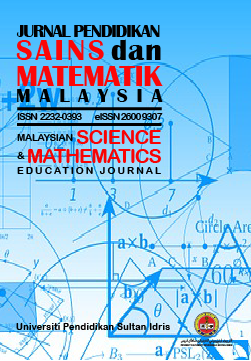The Validity of Teaching and Learning Module Integrated Challenge-Based Learning Methods in Topic Consumer Mathematics
Kesahan Modul Pengajaran dan Pembelajaran Berintegrasikan Kaedah Pembelajaran Berasaskan Cabaran bagi Tajuk Matematik Pengguna
DOI:
https://doi.org/10.37134/jpsmm.vol13.1.10.2023Keywords:
Challenge-Based Learning, Consumer Mathematics, ADDIE Model, Gerlach and Ely Model, thinking skillsAbstract
This study aims to administer the validity of the teaching and learning module (PdP) that integrates the Challenge Based Learning (PBC). This module is also known as the CHABLE (CHAllenge Based Learning) module in the learning of Consumer Mathematics. In this study, the research design used is Develop and Design Research (DDR). This CHABLE module uses a combination of the ADDIE model and the Gerlach and Ely model. This built module contains four learning units found in user mathematics titles. The topics are savings and investments, credit and debt management, financial planning and management and personal financial plans. In order to achieve the objectives of the study, the validity of the module was assessed by experts in the field by identifying the appropriateness of filling in the module. Two instruments were used, namely the Content Validity Questionnaire (SSKK) and the Module Evaluation Questionnaire (SSPM). Content validity analysis was carried out using the Content Validity Index method (CVI). The findings of the study show that the CHABLE module has a satisfactory level of validity with a CVI value of 1.00. Therefore, the CHABLE Module is believed to be able to be used as a guidance material for mathematics teachers and form 4 students in applying thinking skills to meet the challenges of the present and future.
Downloads
References
Aldoobie, N. (2015). ADDIE Model. American International Journal of Contemporary Research, 5(6), 68-72.
Alifatul Aprilia & Devi Nur Fitriana. (2021). Mindset awal siswa terhadap pembelajaran Matematika yang sulit dan menakutkan. PEDIR: Journal Elmentary Education, 1(2), 28–40.
Anderson, L.W., & Krathwohl, D. R. (2001). A taxonomy for learning, teaching and assessing: A revision of Bloom’s taxonomy of educational objektives. Longman Publishing.
Chua, C. N. & Melur Md Yunus. (2020). RollRoll dice: An effective method to improve writing skills among year 3 pupils in constructing SVOA sentences. Universal Journal of Educational Research, 8, 2368–2382.
Csikszentmihalyi, M. (1975). Beyond Boredom and Anxiety. Jossey-Bass Publishers.
Davis, L. L. (1992). Instrument review: Getting the most from your panel of experts. Applied Nursing Research, 5, 194–197.
Farah Aizar Zaipul Bahari & Salmiza Saleh (2023). Content Validation Procedure: Development of Problem-solving Skills Test (PSST): Jurnal Pendidikan Sains Dan Matematik Malaysia, 13(1), 1–9.
Gerlach, V. S., & Ely, D. P., (1980). Teaching & media: a systematics approach (2nd ed.). Prentice Hall.
Ismail Mohd Zain (2018). A Handbook of the Collaborative Instructional Design System (CIDS) transforming teachers, inspiring learners. Dynamic Global Vision.
Jamaludin Ahmad (2015). Modul motivasi diri (2nd ed.). Dewan Bahasa dan Pustaka.
Masliza Siti Ramli & Nor’ain Mohd Tajuddin (2021). Analisis keperluan untuk membangunkan Modul Pembelajaran Berasaskan Challenge dalam Mempelajari Matematik bagi murid tingkatan 4. Jurnal Pendidikan Sains Dan Matematik Malaysia, 11, 50-58.
Md Noor Saper, Nurul Ain Mohd Daud & Norazani Ahmad. (2016). Kesahan dan Kebolehpercayaan Modul I-Sc (Islamic Spiritual Counseling) ke atas Pelajar Bermasalah Tingkah Laku. International Journal of Islamic Thought, 9, 32-43.
Mohd Taufek Harun & Mohd Ikhwan Hadi Yaacob. (2021). Penilaian Kualiti Modul FZ-STEM: Aspek Kesahan dan Kebolehpercayaan. Jurnal Pendidikan Sains Dan Matematik Malaysia, 11, 107-117.
Nee, C & Yunus, M. (2020). RollRoll dice: An effective method to improve writing skills among year 3 pupils in constructing SVOA sentences. Universal Journal of Educational Research, 8, 2368–2382.
Nichols, M., & Cator, K. (2008). Challenge based learning white paper. Apple, Inc.
Nur Humairah Kamarudin, Mazdi Marzuki, Rosmiza Mohd Zainol & Jabil Mapjabil. (2020). Tahap keselamatan pejalan kaki untuk perjalanan ke sekolah, Geografia, 16(4).
Polit, D.E. & Beck, C.T. (2006). Essentials of Nursing Research. 6th Edition. Lippincott Williams & Wilkins.
Russell, J.D. (1974). Modular instruction: A guide to design, selection, utilization and evaluation of modular materials. Burgess Publishing Company.
Sidek Mohd Noh & Jamaludin Ahmad. (2005). Pembinaan Modul: Bagaimana Membina Modul Latihan dan Modul Akademik. Serdang: Penerbit Universiti Putra Malaysia.
Subaramaniam Raman, Muhammad Zuhair Zainal & Fadzilah Amzah. (2023). Pembinaan, Kesahan dan Kebolehpercayaan Modul Penilisan Karangan Bahasa Melayu Tingkatan Dua. Malaysian Journal of Sciences and Humanities, 8(1), 1 – 19.
Vygotsky, L. S. (1978). Mind in society: The development of higher psychological processes. Harvard University Press.
Downloads
Published
Issue
Section
License
Copyright (c) 2023 Masliza Siti Ramli, Sabarina Shafie, Nurihan Nasir

This work is licensed under a Creative Commons Attribution-NonCommercial-ShareAlike 4.0 International License.





